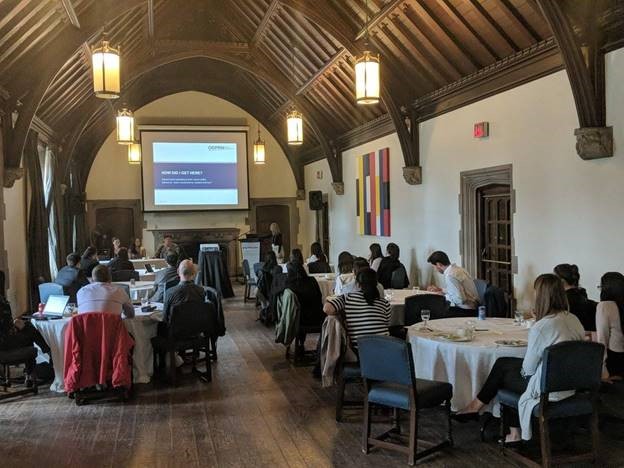Drug Policy 101 builds next generation of researchers
Graduate students in Ontario interested in drug policy research can do a “deep dive” into the subject, thanks to the Ontario Drug Policy Research Network’s (ODPRN)’s Student Training Program. A year-long program that transitioned to virtual during the pandemic, the course offers a multidisciplinary approach with learning modules and webinars, skill-building as well as networking with researchers, policy-makers and industry professionals.
A unique element of the program is its patient-oriented research focus in which students learn about best practices for patient engagement, and meet with ODPRN’s patient partners who help students understand the value of incorporating lived experience into research.

Students at a pre-pandemic networking seminar at the Drug Policy 101 student training program.
“For me, it’s exciting to see so many students from different walks of life who are interested in drug policy and patient-oriented research,” says Dr. Tara Gomes, lead Principal Investigator at ODPRN and an epidemiologist. “It is inspiring to work with them and see how they grow over the course of the program.”
The program is a hands-on example of capacity-building, with the aim of giving young researchers a solid foundation in drug policy research, pharmaco-epidemiological methods, patient-oriented research and knowledge translation. In addition, students participate in networking and collaborative opportunities that help them understand real-life policy decision-making processes.
Students have access to top researchers, such as Dr. Peter Austin, the “guru of propensity scores”, pharmacoepidemiologist and internist Dr. David Juurlink, researchers from CADTH and others who provide comprehensive perspectives on drug policy research.
Particularly valuable is the end-of-year networking event which exposes students to people from government, industry, academia, clinical practice and the patient world. Roundtables during this event provide students with the opportunity to learn best practices on how to engage patients in research, how to develop research that has impact, and tips on grant funding. Further, a “How we got here” panel allows students to glean insights on career trajectories, which are often non-linear, and gain an understanding of what it’s like to work in different sectors.
“This event has been really popular as we bring together people across multiple sectors who candidly talk about their experiences and answer questions on how their careers progressed,” says Dr. Gomes. “It gives students the understanding that you don’t have to have it all figured out. Sometimes a door opens unexpectedly, and if you step through it, it can create opportunities you never expected.”
Since its start in 2017, the program has trained about 100 students from across the province.